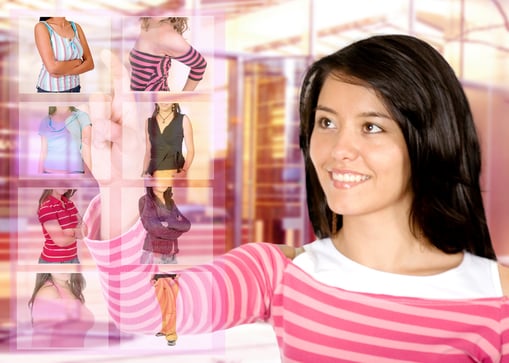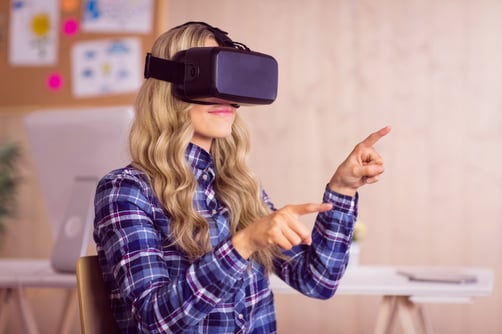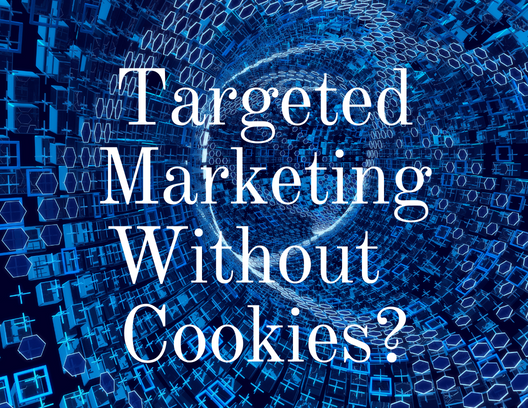How IoT Is Changing The Retail Space
%20with%20multicolored%20radial%20background.jpeg?width=492&name=Internet%20of%20Things%20infographic%20(bitmapped)%20with%20multicolored%20radial%20background.jpeg) Every day, consumers adopt and integrate more and more “things” into our daily lives without even a thought. Things that are connecting us to other things and to people. There was a time when people first began using a device, a desktop or laptop, to connect to the internet. Now, we have multiple devices, not just connected to the internet but inextricably connected to each other in one way or another.
Every day, consumers adopt and integrate more and more “things” into our daily lives without even a thought. Things that are connecting us to other things and to people. There was a time when people first began using a device, a desktop or laptop, to connect to the internet. Now, we have multiple devices, not just connected to the internet but inextricably connected to each other in one way or another.
In almost any home, you will not only find home computers, but now we have smart phones and watches, wireless earbuds, smart TVs, wireless printers, smart refrigerators and ovens. And don't forget the ever-popular digital assistants, Alexa and Echo. We have effectively created an inter-network of these “things” that are all sharing information with each other. All of these items, and the way they are connected, make up the Internet of Things.
But there really is no one single way to describe the IoT. The Internet of Things changes depending on the industry in which it is being employed. IoT in retail has the power to revamp and transform stores into advanced digital experiences with a competitive edge.
What is IoT and how is it used in retail?
The IoT is most often described as “a network of physical objects or ‘things’ embedded with electronics, software, sensors and network connectivity, which enables these objects to collect and exchange data.” Generally, IoT refers to items that you wouldn't normally consider connecting to the internet. Computers and smartphones are meant to connect to the internet. But refrigerators, watches, and houses aren't specifically meant for that.
The global market size of IoT technology reached more than $36 billion in 2021, according to Grand View Research. However, as IoT becomes an integral part of retail operations, global revenue value is expected to reach $186.04 Billion.
We have refrigerators that can tell when their filter needs replacing and then go about ordering a new one for us. This involves a network of sensors, internet connectivity, access to a specific store with the parts, and payments channels and security.
So if you're in the business of home appliances, it is easy to see how IoT can benefit your retail sales, but what about the more everyday retail merchant? How can they capitalize on the IoT for their business?
IoT allows modern businesses to reshape themselves into more experienced-based retailers while also improving operational efficiency. IoT can help retail businesses with everything from more accurate and real time inventory management to increased sales to enhanced customer experience and loyalty.
In the retail space, hardware like RFID tags, store beacons and smart shelves link with consumer’s connected devices like smartphones, watches, mobile wallets and apps. Data is transferred back and forth and shared with software analytics. It's easy to see a world where we can utilize those in-depth insights to enhance the customer experience as well as increase sales.
Nowadays, we increasingly use data to engage with shoppers digitally in real time.
The power of this inter-connectivity can help businesses increase brand loyalty and customer satisfaction. Mobile POS, such as wireless tablets, are already bringing the POS system and all of its information straight to the customer. Salesmen are able to check inventory on the spot and assist the customer in finding the right color, size or any other variable the customer needs. Then they’re able to complete the purchase right there, creating a more personalized customer experience than when they stand in line and check out.
IoT creates and enhances a personalized customer experience
Barcodes and smart tags can also help deepen customer relationships. With so many free barcode and QR code scanning apps available, customers are able to easily scan the tag to gather a multitude of information on a product. They can read reviews and look for references on social media to help them gain confidence in their purchase.
In the past, store owners took a more passive approach to monitoring customer behavior. That is no longer the answer. Merchants have tools that can truly gain insight into their customers' wants and needs. Speaking to this is the retail store app customers can download. What better way to interact with your customer on a more personal level? Connectivity allows the app to recognize when a customer enters the store, and can pop up offers or coupons that are specific to that customer or even to the item they are looking at. Store apps can allow customers who are logged in while shopping to check for lower prices, special coupons, or loyalty rewards just for them.
Interactive screens in fitting rooms interact with the consumer to enhance the customer experience. By detecting what they’re trying on, showing them items in other colors, or even suggesting items that pair well, you can create a more personal experience (without any persons…).
In the future, we will see a world of more personalized shopping experiences that have been optimized way beyond any traditional view we are used to today.
IoT’s interconnectivity improves inventory stocking and management
 RFID, or Radio-Frequency Identification, is inventory management on steroids. RFID tags have been shown to bring inventory accuracy to 99%, as well as reduce shrinkage by a whopping 70%! RFID tags also allow businesses to track objects in more ways than a barcode. Barcodes need to be scanned at the register, at which time the POS system records the information as a sale. RFID tags are already connected, giving the business data about what is happening with that product in real time. Including just moving about the store.
RFID, or Radio-Frequency Identification, is inventory management on steroids. RFID tags have been shown to bring inventory accuracy to 99%, as well as reduce shrinkage by a whopping 70%! RFID tags also allow businesses to track objects in more ways than a barcode. Barcodes need to be scanned at the register, at which time the POS system records the information as a sale. RFID tags are already connected, giving the business data about what is happening with that product in real time. Including just moving about the store.
RFID tags can do many things at once. They can allow a customer to use a smartphone to pay for a product before leaving the store. They can immediately update store inventory that there is one less item on the shelf and in inventory tracking as a whole. And they can simultaneously send data to the owner as to how the customer interacts with the object. For instance, how long the customer spent with the object before purchase, if they tried it on (movement to the dressing room), and which colors are the most popular, etc.
Because items are logged as sold as soon as the transaction is complete, the system can be programmed to send real-time data to the appropriate entities. Employees can be notified that the shelf needs to be restocked. And when inventory hits a specified threshold, it could be programmed to trigger an order for a shipment from the warehouse.
Smart shelves are another technology larger retailers, such as Kohls, use to improve inventory management. RFID technology detects the level of items on the shelf and communicates that to inventory management software. Electronic shelf edge labels allow the price of an item to be changed in real time. No more paying a clerk to put new price stickers on each and every item on the rack. This can save merchants labor costs and allocate employee focus to higher needs.
Real time reporting of all of this pertinent information helps a business to make better decisions. The ability to track inventory status means you’ll be more on top of replenishment, have more consistency in store, and have a better handle on customer demand.
What is the future of IoT in the retail space?
Implementing IoT technologies, and all that goes with it is not without its challenges and investment. While the foundation of IoT lies with RFID enabling this uber-connected environment, it can’t be done without a multitude of supporting devices.
Smart shelves, doors, sensors, as well as device management, security systems, energy optimization, payments avenues, new Wi-Fi and Bluetooth technologies and more, all combine to create this interconnected environment.
The IoT is all about data and what you can do with it. This data will empower business owners with a better understanding of their customers' needs and shopping trends.
We expect the retail industry to be a main driver of the growth of IoT. With the power to increase speed in supply chain operations, automate inventory management and increase sales through enhanced customer experience, retail merchants have no choice but to capitalize on these technological advancements.
And, of course, this doesn’t even take into account how all the data these devices are collecting can be put to use outside the actual retail establishment.
IoT and the payments industry are inextricably intertwined. MonerePay leads the way in providing new and emerging payment technologies. Technology such as mobile wallets, contactless payments, and mobile terminals all rely on interconnectivity to provide a seamless buying experience. But they also provide you with the power to accept payments anytime and anywhere. Because, at the end of the line the main goal is a seamless purchase.
We are dedicated to staying at the forefront of new payments technologies and their integration for the benefit of our clients. Our representatives are ETA-Certified Payment Professionals with a dedication to continued education and a professional “Code of Ethics”.
At MonerePay, we have the partnerships, the experience, and the toolset to manage this rapidly evolving industry. Because of this, you can trust that not only have the education, but the integrity to offer you only the best solutions for your business.

(1).jpg)


.jpg)

